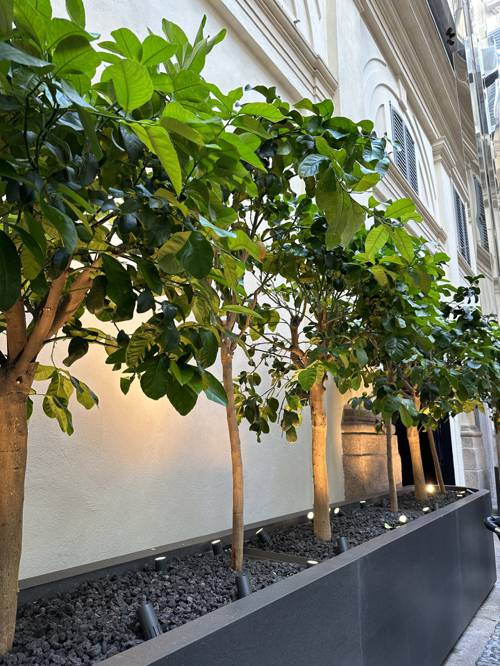
FAQ About Indoor Plants for Eco-Friendly Workspaces

What are the benefits of having indoor plants in a workspace?
Indoor plants offer numerous benefits in a workspace. They improve air quality by absorbing toxins and releasing oxygen, which can reduce symptoms like headaches and eye irritation. Additionally, plants can help in regulating humidity levels and reducing ambient noise. They also enhance the aesthetic appeal of an office, contributing to employees' well-being and productivity by creating a more pleasant environment.

Which indoor plants are best for improving air quality in offices?
Some of the top plants known for improving air quality in offices include the Snake Plant (Sansevieria), Peace Lily (Spathiphyllum), Spider Plant (Chlorophytum comosum), and Dracaena. These plants are effective at filtering out common pollutants such as formaldehyde, benzene, and trichloroethylene, making them ideal for maintaining a healthy indoor environment.

How do indoor plants contribute to eco-friendly office design?
Indoor plants contribute to eco-friendly office design by promoting sustainability through natural air filtration and reduced energy consumption. Plants can lower the office temperature naturally through transpiration, potentially reducing the need for air conditioning. Additionally, they can lessen the reliance on artificial air fresheners and decorations, decreasing the environmental footprint of office spaces.

What are some low-maintenance indoor plants suitable for office environments?
Low-maintenance indoor plants ideal for office settings include the ZZ Plant (Zamioculcas zamiifolia), Pothos (Epipremnum aureum), and Succulents such as Aloe Vera. These plants require minimal watering and are resilient to varying light conditions, making them perfect for busy or less frequently attended office environments.

Can indoor plants reduce stress in the workplace?
Yes, indoor plants can significantly reduce stress in the workplace. Studies have shown that just the presence of plants can lower blood pressure, increase attentiveness, and improve overall mood. The biophilic design concept, which integrates natural elements into workspaces, is known to reduce stress and enhance employee productivity and satisfaction.

How should indoor plants be arranged for maximum effect in an office?
To maximize the benefits of indoor plants, they should be strategically placed throughout the office. Consider using vertical space with hanging plants or green walls, and cluster plants in communal areas like break rooms and conference spaces to create vibrant focal points. Desk plants can be arranged to add personal touch while maintaining desk functionality. It's important to ensure that plants receive adequate light based on their specific needs.

What care tips should be followed for indoor office plants?
When caring for indoor office plants, ensure they are placed in appropriate lighting conditions — not too much direct sunlight for light-sensitive plants. Regularly water them but avoid overwatering, as this can lead to root rot. Using appropriate potting soil and ensuring proper drainage can enhance plant health. Occasional pruning and cleaning of leaves can maintain plant vitality and appearance.

Are there any indoor plants that can help with office acoustics?
Certain indoor plants can help improve office acoustics by absorbing, diffracting, and reflecting sound waves, thereby reducing noise levels. Plants like Rubber Plant (Ficus elastica) and Ferns are known for their dense foliage, which can significantly buffer noise, creating a quieter work environment.

How do plants influence employee productivity?
Research has shown that plants can positively influence employee productivity. The natural presence of greenery can enhance focus, reduce anxiety, and promote creativity. By creating a visually appealing and comfortable atmosphere, plants contribute to increased mental engagement and efficiency.

What types of lighting are ideal for indoor plants in an office?
For indoor plants, natural light is ideal, but many offices rely on fluorescent or LED lighting. Select full-spectrum LED lights that mimic natural sunlight if possible. Ensure that the plants receive enough light without being directly under harsh light, which can cause leaf burn, especially in sunlight-sensitive species.

Can indoor plants help reduce office temperatures?
Plants can indeed help in reducing office temperatures through the process of transpiration, where they release moisture into the air. This process not only cools the air but also can increase humidity levels, which can be beneficial in dry office environments. While the effect is generally mild, strategically placing numerous plants can contribute to noticeable changes in indoor climate.

Are there any indoor plants that are also pet friendly?
Yes, there are several indoor plants that are considered pet-friendly. Examples include the Areca Palm (Dypsis lutescens), Spider Plant (Chlorophytum comosum), and Boston Fern (Nephrolepis exaltata). These plants are non-toxic to pets, making them safe choices for offices where furry companions might visit.

What role do indoor plants have in sustainable office practices?
Indoor plants play a crucial role in sustainable office practices by improving air quality naturally, reducing reliance on artificial products, and promoting employee well-being. Incorporating greenery into office design can complement other sustainability measures such as energy efficiency and waste reduction, enhancing the overall eco-friendliness of the workspace.

Can indoor plants be used in small office spaces?
Yes, indoor plants can be effectively used in small office spaces by choosing compact species that fit the environment. Options like air plants (Tillandsia) or small succulents are excellent as they require minimal space and care. Using vertical gardens or hanging planters can also maximize greenery without taking up floor space.

What are some creative ways to incorporate plants into office design?
Creative ways to incorporate plants into office design include creating living walls, using decorative plant pots that match the office decor, and incorporating planters into or on furniture like desks or bookshelves. Another option is to use tiered plant stands that allow for multiple layers of plants, adding depth and greenery to office environments.

How do indoor plants affect humidity in office environments?
Indoor plants can increase humidity levels in office environments through the process of transpiration, where they release moisture into the air. This can be beneficial in maintaining a balanced indoor climate, particularly in offices with dry air conditions due to heating or air conditioning systems. Increased humidity from plants can help alleviate issues such as dry skin and respiratory discomfort for employees.

Are succulents a good choice for office plants?
Succulents are an excellent choice for office plants because they require minimal maintenance, are drought-tolerant, and can thrive in various lighting conditions. They are compact, making them ideal for desktops or small office spaces, and come in diverse shapes and colors, adding visual interest to workplace design.

What are the benefits of using vertical gardens in offices?
Vertical gardens in offices offer several benefits such as maximizing green space without consuming floor area, enhancing aesthetic appeal, and improving air quality. They contribute to noise reduction and can create striking visual impacts that inspire creativity and boost employee morale.

How can indoor plants contribute to a healthier work environment?
Indoor plants contribute to a healthier work environment by purifying the air, reducing stress, and increasing humidity. By removing toxins and volatile organic compounds from the air, plants create a healthier breathing space. Their presence in offices can lead to improved mental health and well-being for employees, contributing to reduced sickness and increased workplace satisfaction.

What should be considered when selecting indoor plants for a workspace?
When selecting indoor plants for a workspace, consider factors such as light availability, space constraints, maintenance requirements, and any potential allergies or sensitivities among employees. It's important to choose plants that can thrive in your specific office environment and match the overall aesthetic and functionality of the workspace.
